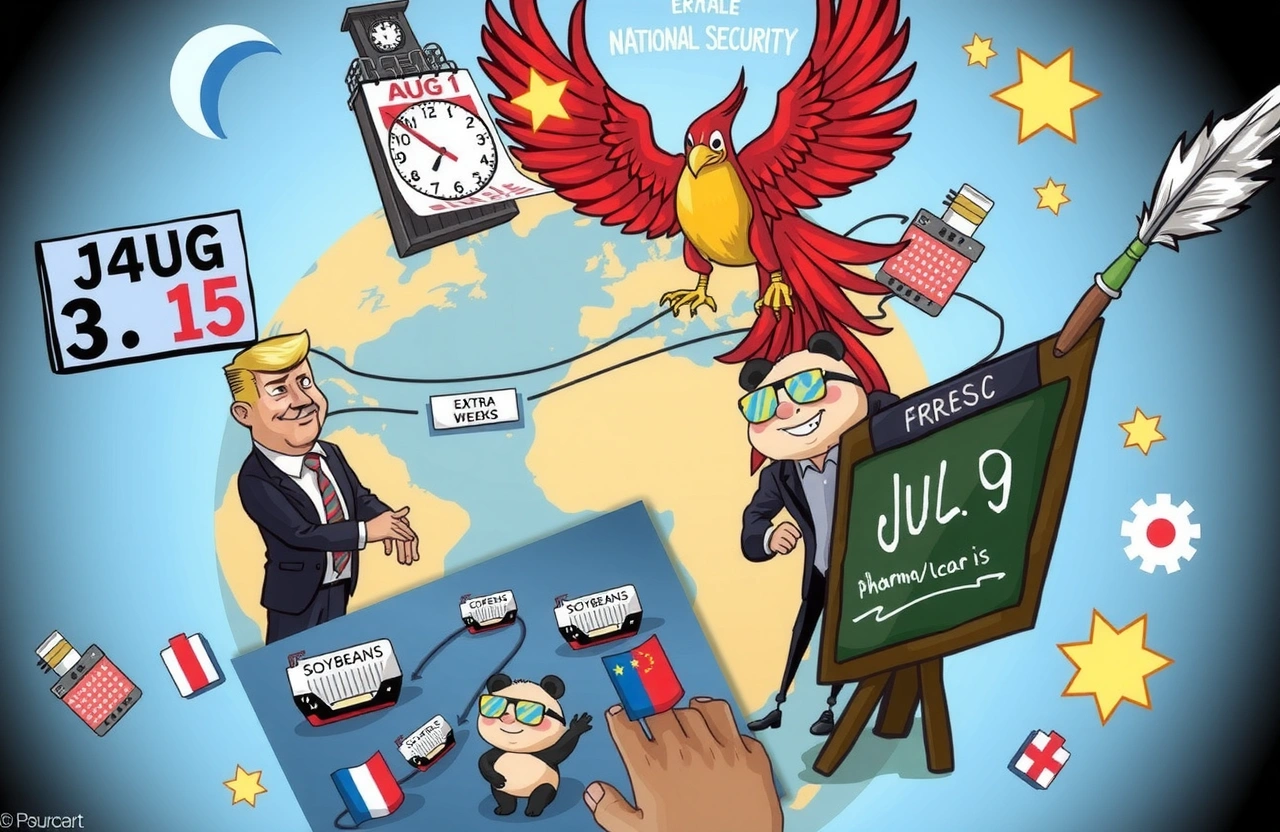– President Trump’s new tariffs on multiple nations will take effect August 1 instead of July 9
– Commerce Secretary Howard Lutnick (卢特尼克) confirmed the extension with tariff rates pending finalization
– Trading partners gain three additional weeks for last-minute negotiations
– Trump claims deals or agreements acknowledgment letters will arrive July 9–10
The international trade landscape jolted this week as U.S. Commerce Secretary Howard Lutnick (卢特尼克) unveiled a crucial tariff deadline extension. Standing beside President Donald Trump (唐纳德·特朗普) at Morristown Airport on Sunday evening, Lutnick declared sweeping tariffs on key trading partners would now take effect August 1—postponing the previously announced July 9 deadline. This surprising reprieve offers global markets and multinational corporations a vital buffer against potential disruptions. Stakeholders worldwide now face three urgent weeks to secure concessions as Trump simultaneously declared agreements would be formalized this week via “letters or finalized deals.” With this tariff deadline extension reshaping supply chains worldwide, businesses must strategically navigate evolving economic diplomacy that could impact every sector from semiconductor chips to soybean exports.
The Deadline Shift: Decoding Washington’s Strategy
President Donald Trump (唐纳德·特朗普) had initially issued a July 9 ultimatum for trading partners, staking his trademark hardline position while preparing to board Marine One at New Jersey’s Morristown Airport. Emerging press reports captured his unambiguous declaration: “I think by July 9, we’ll have results—either letters or agreements from most countries”. Yet in revealing this tariff deadline extension, Commerce Secretary Howard Lutnick (卢特尼克) executed a tactical pivot with profound economic implications.
The Role of Global Feedback and Negotiation Pressures
Observers detected distinct patterns behind this tariff deadline extension—signaling amplified tensions within White House economic strategy circles. Key factors driving this timeline shift include:
– Outcry from Republican senators representing agricultural states facing devastating export impacts
– Pavement of consultation loopholes for European Union counterparts seeking fourth-quarter quota adjustments
– Electronics industry lobbyists proving current timelines made contingency planning impossible
Breaking Down the New August 1 Timeline
August 1 now marks the definitive global tariff trigger date. U.S. regulatory commissions received preliminary documents outlining these transitions at 8:47 AM EDT Monday. Commerce Secretary Howard Lutnick (卢特尼克) emphasized the administration would publish final tariff tiers covering five sectors by July 20. This tariff deadline extension structure includes three non-negotiable implementation phases:
Sector-Specific Tariff Exposure Guide
– Automotive: 20-25% preliminary duty rates on select assembly components
– Industrial machinery: Automation parts facing graduated structure averaging 15-18%
– Semiconductor materials: Miracle-metal gallium arsenide tariffs starting at 25%
– Pharmaceuticals: Raw active ingredients from biodiversity-dense nations subject to 10-12% tariffs
– Agriculture: Poultry/ethanol tariffs plateauing at 22%
These hit businesses dependent on cross-border inputs hardest according to a U.S. Trade Representative memo.
Geopolitical Earthquake: Trading Partners Respond
Finance ministers across exported-dependent economies scrambled post-announcement. Chinese Ministry of Commerce representative Wang Lei (王磊) stated, “Market-based solutions respecting global supply chains provide the only sensible framework.” Beyond populous pacific nations, EU Commissioner Valdis Dombrovskis labeled August 1 “deal or no-deal day,” stressing agricultural concessions remained nonnegotiable. Historical precedence confirms this tariff deadline extension contrasts sharply with patterns seen during prior geopolitical standoffs involving:
Immediate Financial Market Responses
Analysts tracked predictable yet volatile capital movement patterns upon Monday’s opening bell:
– Agricultural commodities futures dropped 2.7% collectively, led by corn and soybean dips
– NASDAQ semiconductor indices climbed 1.9% amid diluted offshore manufacturing risks
– Euro vs. dollar pairs stabilized after 48 hours of wild swings, suggesting disciplined dark pool investor activity
– Emerging market bonds faced selling imbalances throughout Latin American and Southeast Asian exchanges
Corporate Survival Strategies As Deadlines Loom
Global sourcing directors face immediate operational overhauls. Three survival imperatives emerged from executive forums:
Immediate Steps Recommended by Industry Advisors
– Apply for Product Exclusion Requests using Department of Commerce multi-form documentation portals open July 10
– Retain specialized Section 301 assessment counselors to determine product reclassification options
– Petition for temporary Foreign Trade Zone warehousing access ahead of product modification timetables
Legal experts now advocate filing injunction motions before July 15 to secure judicial holds before August 1 implementation. Coordinated efforts to strategically exploit the tariff deadline extension could mean the difference between profitability and corporate collapse.
Predicting Endgame Scenarios After the Extension
Washington insiders envision three possible outcomes reflecting the maneuverable space created by this tariff deadline extension:
Potential Resolution Frameworks
– Best Case: Comprehensive U.S.-EU agreement combined with three bilateral Asian trade pacts signed July 25 with tariff reductions worth $192B
– Middle Scenario: Pared-down agreements with Vietnam, Thailand and Brazil alongside escalated duties applied exclusively to Mexico
– Worst Outcome: Full August tariff implementation triggering multi-country WTO filings and retaliatory sanctions on U.S. specialty exports
This tariff deadline extension fundamentally reshuffles negotiation dynamics once imaginable under the hard threats of the July 9 deadline.
Navigating Post-Deadline Global Commerce Frontiers
With this tariff deadline extension a live economic reality, proactive multinationals undertake unprecedented strategic reconfigurations spanning multiple time horizons. Supply chain architects must immediately implement three structural changes:
Transition Protocols
– Southern ASEAN shift towards high-volume localized production with Indonesia/Malaysia Epoxy technology parks
– Nearshore boom for Mexico’s Baja region aerospace factories enabling much faster North American distribution
– Warehouse automation investments increasing domestic 3PL resilience alongside blockchain inventory tracking innovations
Supply diversification justification models illustrate 112% IRR possible through prudent transitional moves. Ultimately, the August 1 deadline growth acceleration mandate these transitions despite temporary market disruptions; those seizing this tariff deadline extension decisively position themselves for economical advantages that could last decades.
Revisit your entity’s upstream risks using Customs Bureau’s Harmonized Tariff Schedule match tool today before July 9 correspondence windows close. Engage specialized trade attorneys immediately to evaluate exemption petition strategies fitting your operational footprint. With ports already overwhelmed by accelerated shipments racing to beat August duties, decisive adaptation becomes impossible to delay. Subscribe to global trade intelligence alerts now for live coverage of President Trump (唐纳德·特朗普) and Secretary Lutnick’s unfolding tariff deadline extension negotiations as the world’s economic future hangs in delicate balance.




